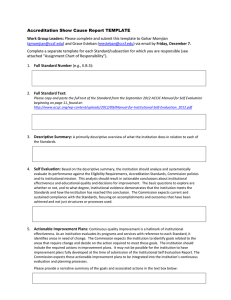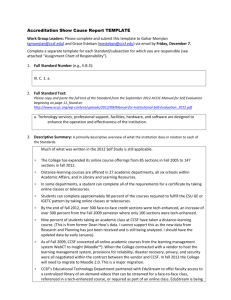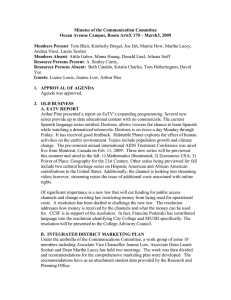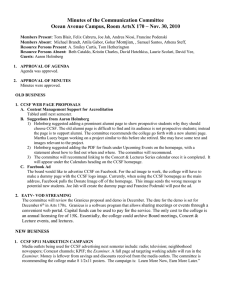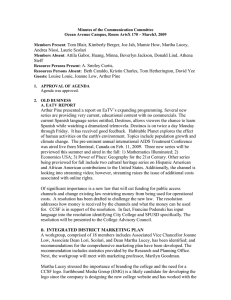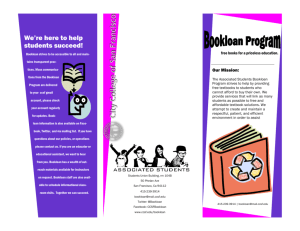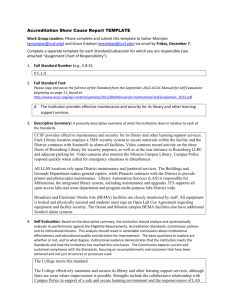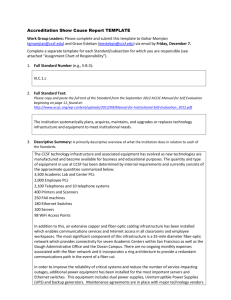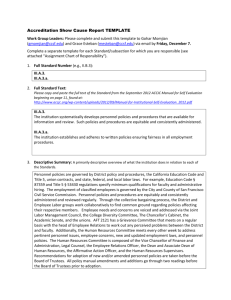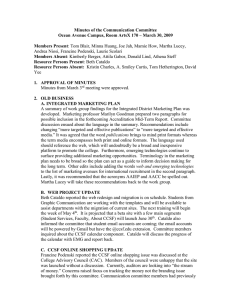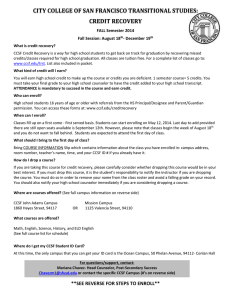Accreditation Show Cause Report TEMPLATE Work Group Leaders
advertisement
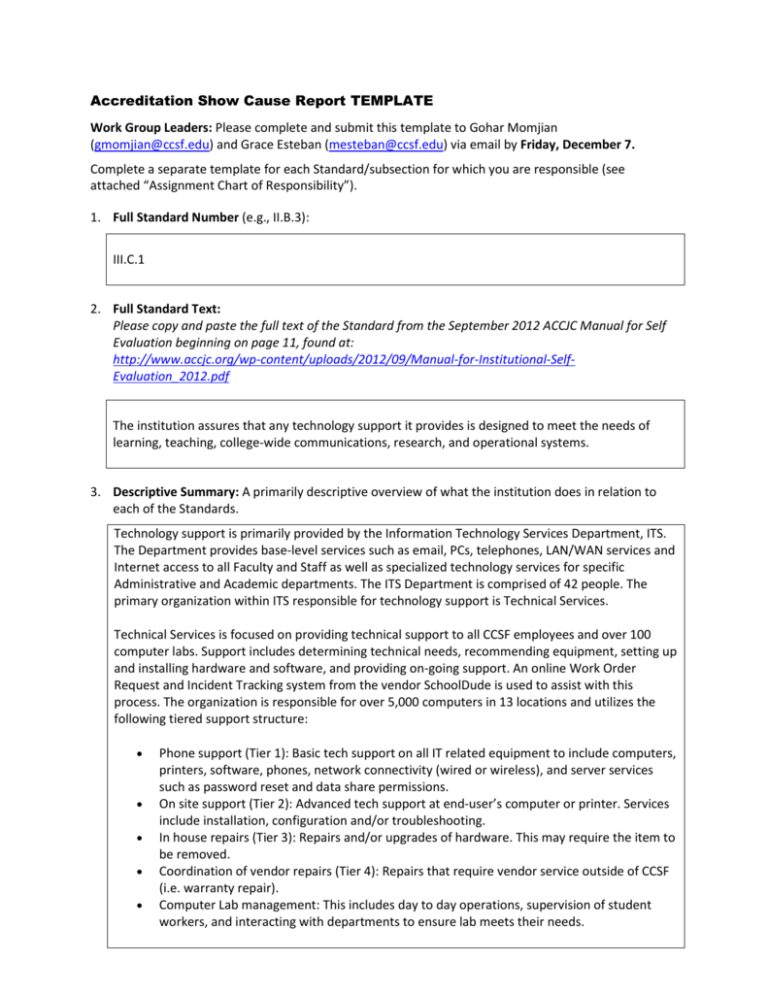
Accreditation Show Cause Report TEMPLATE Work Group Leaders: Please complete and submit this template to Gohar Momjian (gmomjian@ccsf.edu) and Grace Esteban (mesteban@ccsf.edu) via email by Friday, December 7. Complete a separate template for each Standard/subsection for which you are responsible (see attached “Assignment Chart of Responsibility”). 1. Full Standard Number (e.g., II.B.3): III.C.1 2. Full Standard Text: Please copy and paste the full text of the Standard from the September 2012 ACCJC Manual for Self Evaluation beginning on page 11, found at: http://www.accjc.org/wp-content/uploads/2012/09/Manual-for-Institutional-SelfEvaluation_2012.pdf The institution assures that any technology support it provides is designed to meet the needs of learning, teaching, college-wide communications, research, and operational systems. 3. Descriptive Summary: A primarily descriptive overview of what the institution does in relation to each of the Standards. Technology support is primarily provided by the Information Technology Services Department, ITS. The Department provides base-level services such as email, PCs, telephones, LAN/WAN services and Internet access to all Faculty and Staff as well as specialized technology services for specific Administrative and Academic departments. The ITS Department is comprised of 42 people. The primary organization within ITS responsible for technology support is Technical Services. Technical Services is focused on providing technical support to all CCSF employees and over 100 computer labs. Support includes determining technical needs, recommending equipment, setting up and installing hardware and software, and providing on-going support. An online Work Order Request and Incident Tracking system from the vendor SchoolDude is used to assist with this process. The organization is responsible for over 5,000 computers in 13 locations and utilizes the following tiered support structure: Phone support (Tier 1): Basic tech support on all IT related equipment to include computers, printers, software, phones, network connectivity (wired or wireless), and server services such as password reset and data share permissions. On site support (Tier 2): Advanced tech support at end-user’s computer or printer. Services include installation, configuration and/or troubleshooting. In house repairs (Tier 3): Repairs and/or upgrades of hardware. This may require the item to be removed. Coordination of vendor repairs (Tier 4): Repairs that require vendor service outside of CCSF (i.e. warranty repair). Computer Lab management: This includes day to day operations, supervision of student workers, and interacting with departments to ensure lab meets their needs. In addition to ITS, the following CCSF Departments employ an additional 20 technology support staff: Admissions and Records (A&R), Disabled Students Programs/Services (DSPS), Educational Technology Department (ETD), Financial Aid; Finance, Human Resources (HR), Matriculation and the Library. In order to directly meet their technology needs, the priorities and direction of activities for the technology support staff in this category is provided by the managers of the department in which they are located. In 2011 an attempt was made to reorganize all technology staff into the ITS Department. This reorganization was not completed and hence some IT staff are in non-IT departments and report to non-IT supervisors. All major systems supported by the ITS Department are proactively monitored and supported using system management tools consisting of online applications and associated databases. The specific systems monitored include Ethernet switches, WiFi, Internet Utilization, Telephone systems, Storage Area Networks and Firewalls. 4. Self Evaluation: Based on the descriptive summary, the institution should analyze and systematically evaluate its performance against the Eligibility Requirements, Accreditation Standards, Commission policies and its institutional mission. This analysis should result in actionable conclusions about institutional effectiveness and educational quality and decisions for improvement. The basic questions to explore are whether or not, and to what degree, institutional evidence demonstrates that the institution meets the Standards and how the institution has reached this conclusion. The Commission expects current and sustained compliance with the Standards, focusing on accomplishments and outcomes that have been achieved and not just structures or processes used. CCSF partially meets this standard. Evidence: Work Order and Incident Tracking System Evidence: System Management Examples Future Need: Closer integration is required with Program Review to ensure alignment with learning, teaching, college-wide communications, research, and operational systems. Future Need: A Technology Survey needs to be conducted on a regular basis to assess the effectiveness of technology and receive suggestions for improvement. Future Need: The ITS Technology Services organization requires expansion in order to provide technical assistance during evenings and weekends. 5. Actionable Improvement Plans: Continuous quality improvement is a hallmark of institutional effectiveness. As an institution evaluates its programs and services with reference to each Standard, it identifies areas in need of change. The Commission expects the institution to identify goals related to the areas that require change and decide on the action required to meet these goals. The institution should include the required actions in improvement plans. It may not be possible for the institution to have improvement plans fully developed at the time of submission of the Institutional Self Evaluation Report. The Commission expects these actionable improvement plans to be integrated into the institution’s continuous evaluation and planning processes. Please provide a narrative summary of the goals and associated actions in the text box below: Establish Technology Priorities Measure Effectiveness of Technology Expand Technology Services Please complete the table below to summarize the goals and actions described above as concisely as possible (add rows as needed): Goal Associated Action(s) Expected Completion Date Establish Technology Priorities Program Review (annually) June 1, 2013 Measure Effectiveness of Technology Technology Survey (every 3 years) July 1, 2013 Expand Technology Services Hire/Reallocate Additional Staff (2) December 31, 2014
